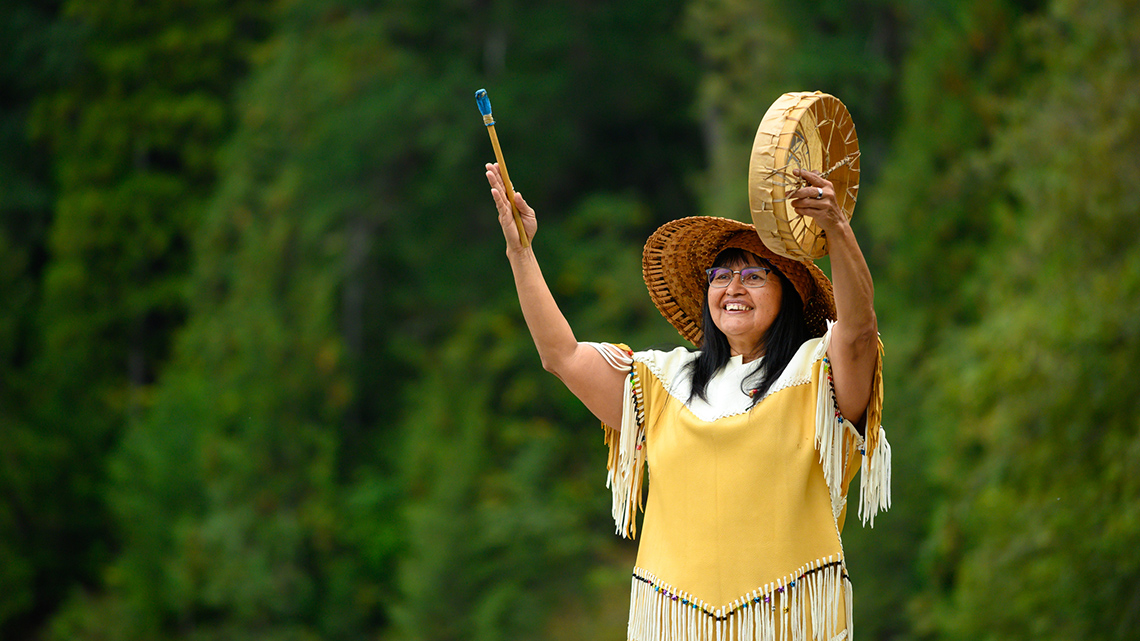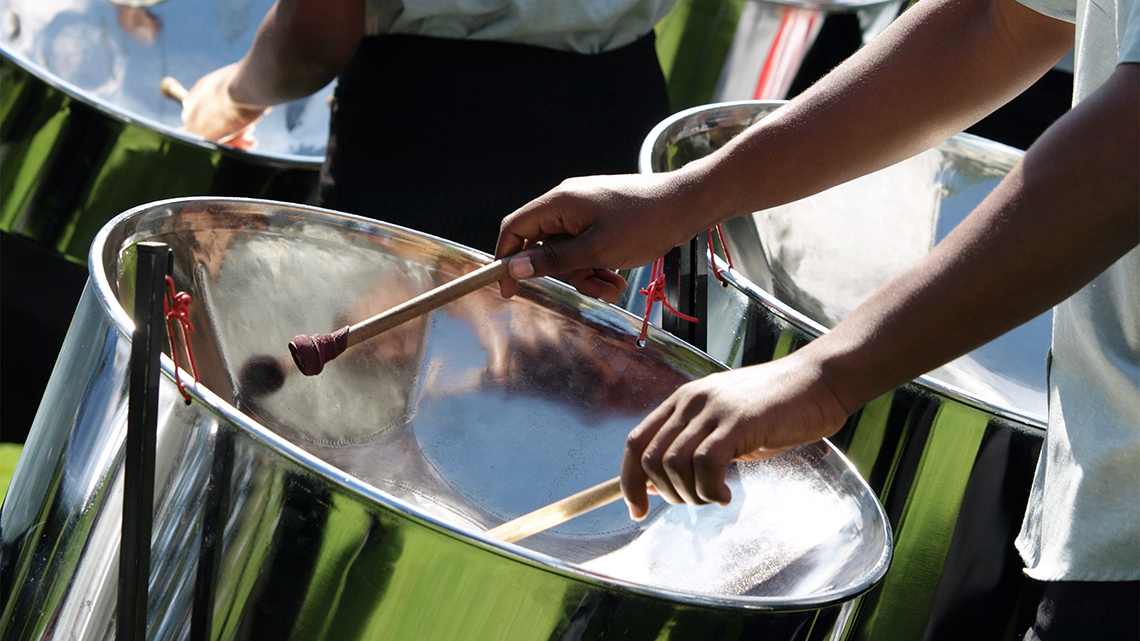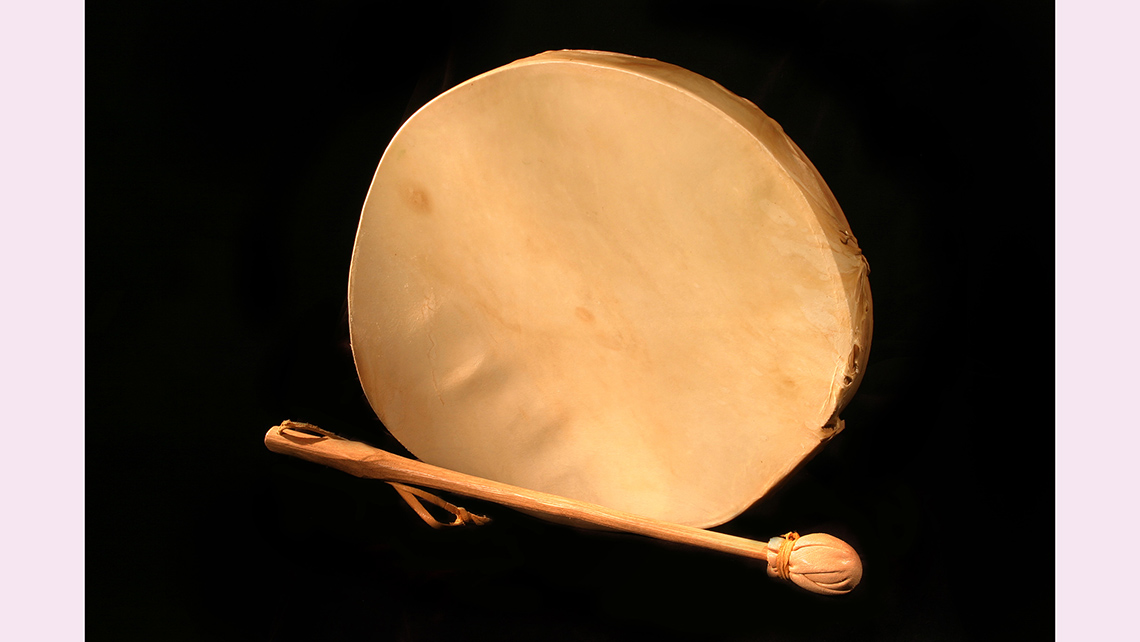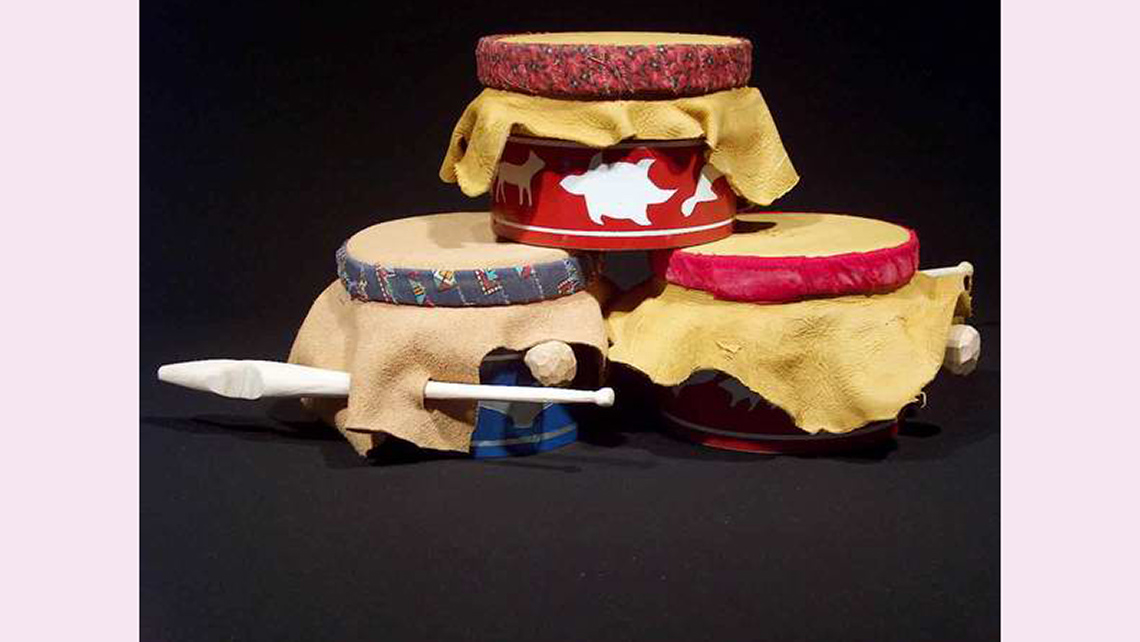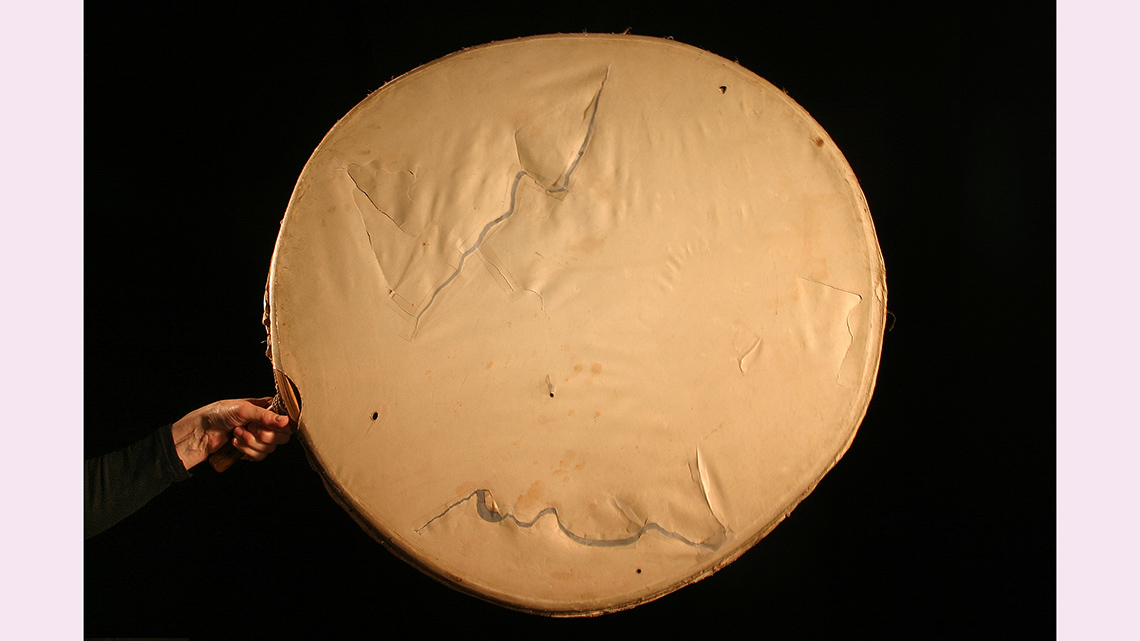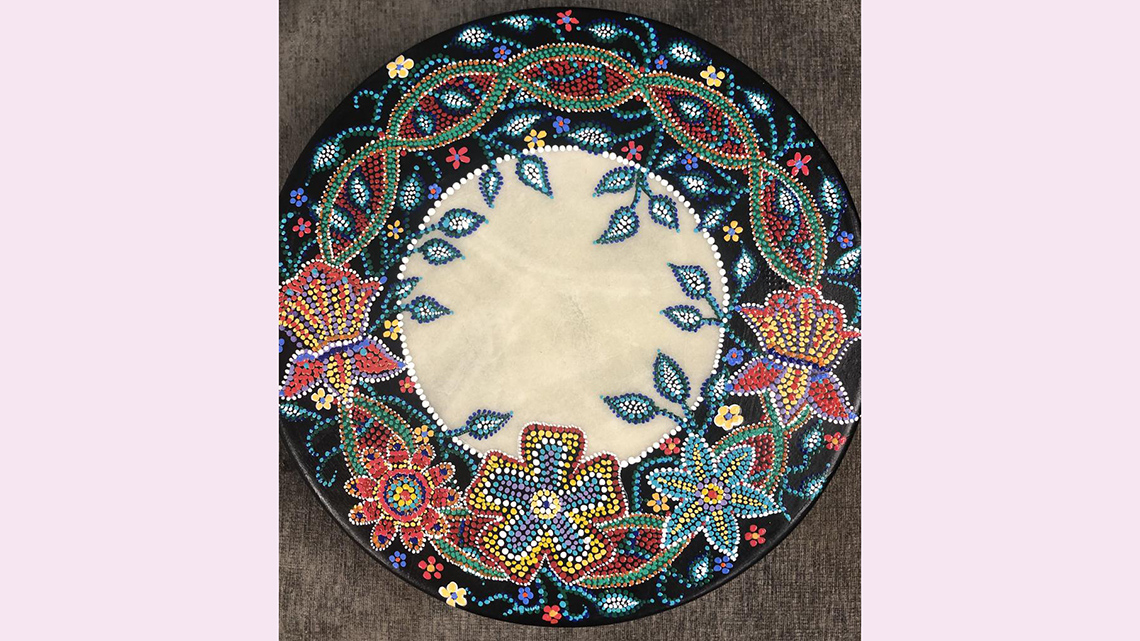Minds On
Today’s vocabulary
Press the following tabs to access today’s vocabulary.
An instrument that one has to hit, scrape, or rattle in order to make a sound. Percussion instruments are typically classified as pitched (e.g., xylophone) and non-pitched (e.g., maracas).
Indigenous hand drums often represent the heartbeat of Mother Earth. There are many diverse types of hand drums made by First Nations, Métis and Inuit peoples, and each has its own meaning and tradition.
The steelpan is a musical instrument that originated in Trinidad and Tobago. Modern ones are made from 55 gallon industrial drums.
A djembe is a drum that is shaped like a goblet and is covered in rawhide. It is originally from West Africa and is meant to be played with bare hands. The drum is very loud and can produce a wide variety of sounds.
Let’s get started!
Exploring instruments
Explore the following images and descriptions.
What do you notice is similar and/or different about the instruments in each image?
Press ‘Answer’ to check out the similarity between all of the instruments you explored.
All of these instruments are examples of drums!
Brainstorm what you already know about drums. Complete only the “Know” column from the Know, Wonder, Learn chart in your notebook or using the following fillable and printable document.
|
What I Know |
What I Wonder |
What I Learned |
|---|---|---|
|
What do I know about drums from diverse communities around the world? What are the names of the types of drums I know? |
Press the ‘Activity’ button to access Know, Wonder, Learn.
Action
Get ready, get set…
What are drums?

Drums are percussion instruments and play a role in musical traditions around the world from early times to today.
As you may have noticed in the images in Minds On, drums can vary greatly in size, shape, style and construction, and they also represent a wide variety of cultures.
What is a percussive instrument?
An instrument that one has to hit, scrape, or rattle in order to make a sound. Percussion instruments are typically classified as pitched (e.g., xylophone) and non-pitched (e.g., maracas).
First Nations, Métis and Inuit hand drums
There is a rich cultural tapestry of drums from around the world. The diverse styles and purposes of these instruments are as diverse and unique as the individual communities they come from. For example, a drum can vary greatly between First Nations, Métis and Inuit communities.
Canada recognizes these three distinct Indigenous groups, but there are over 600 different Nations and communities.
The type of drum can vary depending on which specific community it comes from. For example, there might be slight variations in the style, materials and designs used between two Cree communities or two Inuit communities. These variations are what make each community and drum unique!
Explore the following carousel of drums from First Nations, Métis, and Inuit communities across Canada. Each drum has a specific significance to its community.
There are many diverse types of Indigenous hand drums, and each has its own meaning and tradition. Check out the following two video clips to learn more about Indigenous hand drums and to explore a hand drum performance.
In the following video clip, iskwé, a Métis and Cree singer-songwriter describes and demonstrates how to use a traditional hand drum from her own community. This style and type of hand drum is used in many First Nations and Métis communities.
Access the following video entitled Backyard Beats: “Indigenous Hand Drum” to learn more about the musician iskwé's hand drum.
Check out the following video entitled Backyard Beats: “Indigenous Hand Drum” to explore a hand drum performance by iskwé, Monica and Junior Jammer Lovely.
Consider what you have learned as you explored the previous videos.
Complete the Indigenous Hand Drums graphic organizer in your notebook or using the following fillable and printable document.
|
Name of drum: |
|
|
How is the drum played? |
|
|
Why is the drum special to iskwé? |
|
|
In iskwé’s community, what do you do after you make your first drum? |
|
|
What is Lovely’s drum made of? |
|
|
What are Lovely’s top tips for playing a drum? |
|
|
When is the hand drum played? |
Press the ‘Activity’ button to access Indigenous Hand Drums.
Press ‘Hint’ to explore some possible responses.
Check out the following Indigenous Hand Drums Answer Key to consider possible answers.
|
Name of drum: |
Indigenous hand drum |
|
How is the drum played? |
The drum is played with mallets. |
|
Why is the drum special to iskwé? |
iskwé shares that the drum represents the heartbeat of the earth, so when they play the drum it connects them with their ancestors and the earth. |
|
In iskwé’s community, what do you do after you make your first drum? |
The first drum that you create is given to someone special. It is a way to spread positive energy. iskwé received the drum that they brought to Backyard Beats from their wife. |
|
What is Lovely’s traditional drum made of? |
The case of the drum is made of wood. The membrane is made of deer hide and the strings are made of sinew. |
|
What are Lovely’s top tips for playing a drum? |
Tip 1: Be strong Tip 2: Love your drum and care for it. Tip 3: Be respectful to your drum. Hold and it play it the proper way. |
|
When is the drum played? |
The drum is played at times of gathering, such as pow wows and other celebrations. |
Press the ‘Activity’ button to access Indigenous Hand Drums Answer Key.
Go!
Wondering about drums
Now that we have broadened our knowledge of Indigenous hand drums, let’s revisit our thinking from Minds On.
Let’s add what you are wondering about drums by adding to your Know, Wonder, Learn chart. Complete the “Wonder” column from the Know, Wonder, Learn chart in your notebook or using the following fillable and printable document.
|
What I Know |
What I Wonder |
What I Learned |
|---|---|---|
|
What do I know about drums from diverse communities around the world? What are the names of the types of drums I know? |
Are there any questions you still have about drums, in general? What do I want to know about diverse drums from around the world? |
Press the ‘Activity’ button to access Know, Wonder, Learn.

Two teachers are having a discussion. The first teacher shares: “Learning about drums from around the world not only helps us understand percussion and rhythm better, but it can also strengthen our respect for the cultures that produced these instruments”. The second teacher responds: “That’s right! Learning about a drum’s purpose and cultural background is just as important as knowing how it sounds and how it is played. Even drums that appear different from each other could have the same cultural purpose!”
In the following videos, you will be introduced to the djembe and the steelpan. After you have explored the four videos, you will share your learning in a graphic organizer.
First, check out the following video about the djembe entitled Backyard Beats: “The Djembe”.
Explore the following video entitled Backyard Beats: “The Djembe” to access a performance by djambe musician Amara Kante and Junior Jammer Kairo.
Access the following video entitled Backyard Beats: “Steelpan” to learn more about steelpans.
Now check out the following video entitled Backyard Beats: “Steelpan” explore a steelpan performance.
Complete the Djembe and Steelpan graphic organizer in your notebook or using the following fillable and printable document.
|
Name of Drum: Steelpan |
Name of Drum: Djembe |
|---|---|
|
How is the steelpan played? |
How do you play the djembe? |
|
Where was the steelpan invented? |
Where does the djembe come from? |
|
What materials were used to make the steelpan originally? |
What kind of materials are used to make the djembe? |
|
Why does Joy enjoy playing the steelpan? |
Why do people play the djembe? |
|
What is the most challenging part about playing the steelpan? |
What is the most challenging part about playing the djembe? |
|
What do you notice about the piece that is performed during their jam session? |
What do you notice about the piece that is performed during their jam session? |
Press the ‘Activity’ button to access Djembe and Steelpan.
Consolidation
Putting it all together
Reflecting on our learning

Sometimes our ideas about a topic can change based on what we’ve learned.
Let’s return to the Know, Wonder, Learn chart we started to explore in Minds-On and consider what you already knew about drums at the beginning of this learning activity. How has that changed?
Let’s add what you have learned. Complete the “Learn” column from the Know, Wonder, Learn chart in your notebook or using the following fillable and printable document.
|
What I Know |
What I Wonder |
What I Learned |
|---|---|---|
|
What do I know about drums from diverse communities around the world? What are the names of the types of drums I know? |
Are there any questions you still have about drums, in general? What do I want to know about diverse drums from around the world? |
What new information have I learned about drums? Are there any ideas I learned that changed what I originally thought about drums? |
Press the ‘Activity’ button to access Know, Wonder, Learn.
Reflection
As you read through these descriptions, which sentence best describes how you are feeling about your understanding of this learning activity? Press the button that is beside this sentence.
I feel…
Now, record your ideas using a voice recorder, speech-to-text, or writing tool.
Press ‘Discover More’ to extend your skills.
Discover MoreDig deeper into the world of drums

Select a diverse drum that you would like to investigate further. If you are familiar with a drum from your own cultural background, you may investigate that type of drum, or it can be any other type of your choice. You may record your findings using the following Know, Wonder, Learn graphic organizer or using a method of your choice.
When researching a drum of your choice, it is important that you begin your search using websites, videos, audio recordings or print resources from the community you are studying, Canadian encyclopedia websites, or Canadian Arts organizations’ websites.
Make sure to add the links you used to the “Sources” section in the graphic organizer provided or by a method of your choice.
Thinking critically about using websites
Websites ending with .com, .org, and .net can be purchased and used by any person. Be careful when using these websites and ask yourself if these websites are credible or have bias. The ending .org are usually used by non-profit organizations which may have an agenda of persuasion rather than education. If researching an Indigenous drum, try to find websites from that particular community so that you know the teachings and knowledges are accurate and authentic.
Websites ending in .edu are reserved for colleges and universities. Canadian websites have .ca ending. It is important to consider using credible Canadian websites for research when possible!
|
Name of drum: |
Indigenous hand drum |
|
Sources |
|
|
Who plays the drum? |
|
|
When is the drum played? |
|
|
Where does the drum originate? |
|
|
What is the drum made of? |
|
|
Why is this drum special? |
Press the ‘Activity’ button to access Know, Wonder, Learn.
